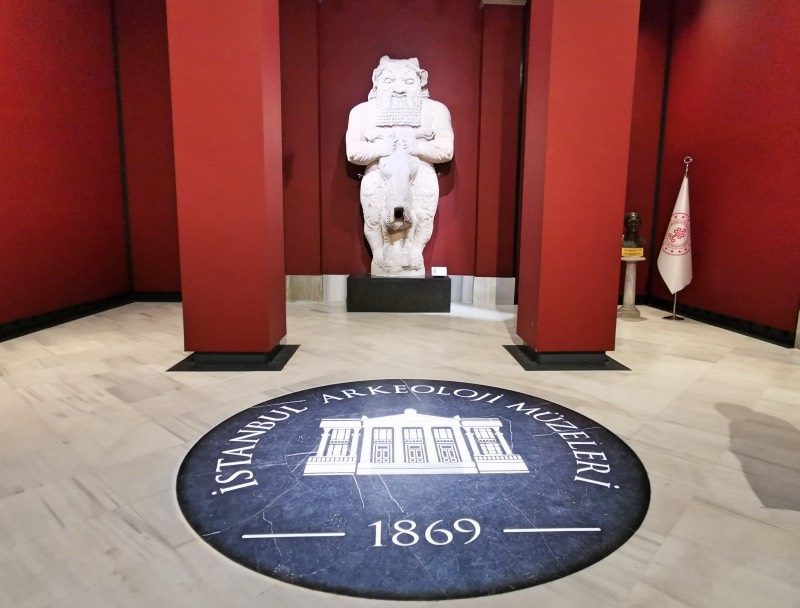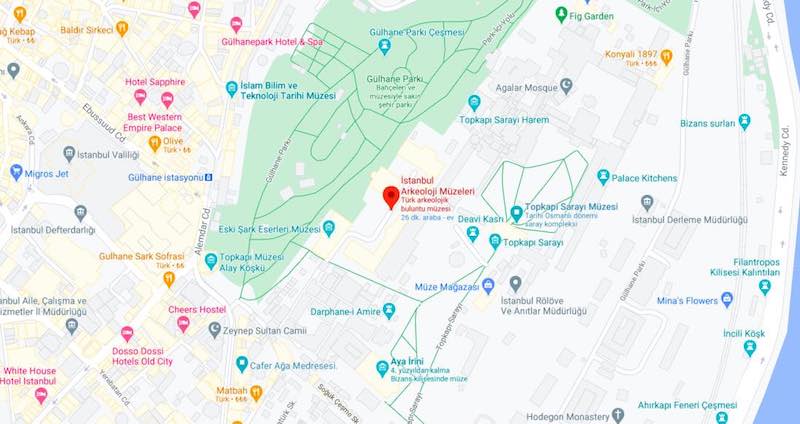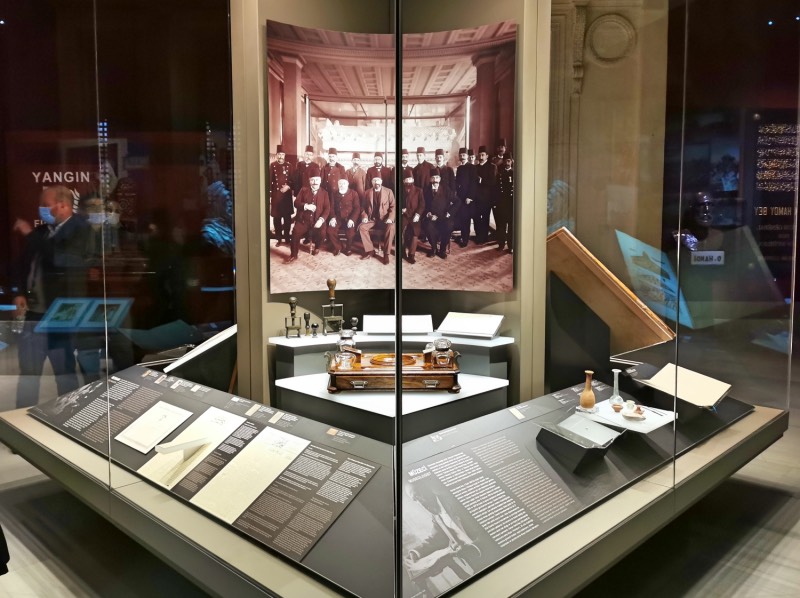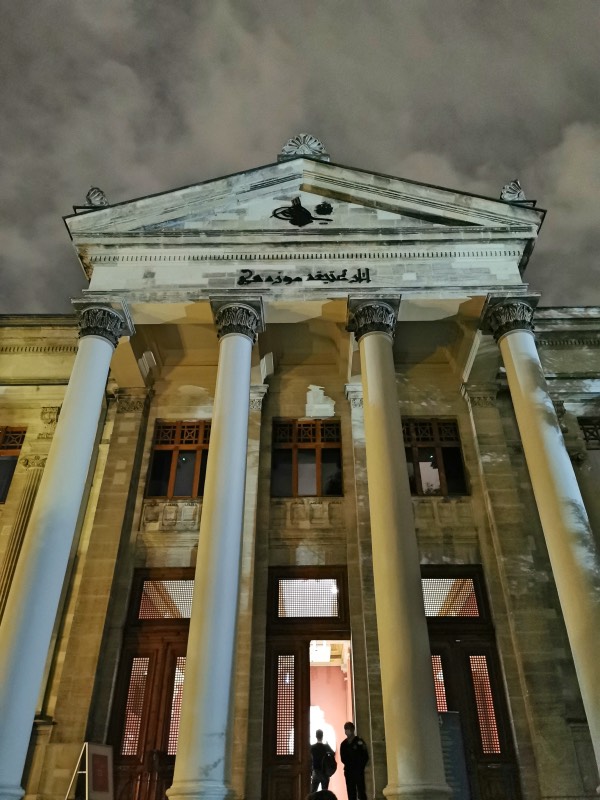The first building of our country built as a museum, the first museum, one of the largest museums in the world, home to more than 1 million works from a wide geography from Anatolia to the lands of the Ottoman Empire. Istanbul Archaeological Museums, a museum complex consisting of 3 buildings, therefore its name is referred to as "museums", not "museum". If I go to Istanbul Archeology Museums many times, I will not get bored. Fifty Shades of Travel account, which organizes boutique trips A Night at the Archaeological Museums When I saw the promo, I thought I shouldn't miss it. In this article, I will explain both the Archeology Museums and the details of my experience during a night at the museum, enjoy reading!

A Night at the Archaeological Museums trip is repeated often, Fifty Shades of Travel instagram accountYou can follow the announcements.
What You Will Find In This Article
Where is Istanbul Archeology Museums and How to Go?
Istanbul Archeology Museums are located in the Historical Peninsula in the Sultanahmet district. The entrance to the museum is on the left, on Osman Hamdi Bey Slope, between the Hagia Sophia Mosque and the Topkapi Palace's Gulhane Park entrance, if you follow the tramway. It is impossible to overlook the high iron railing door. on Google Maps Click for location.

The easiest way to go to the Archeology Museums is to use the Bağcılar-Kabataş tram. If you get off the tram at the Gülhane Park stop, you can easily reach the museum entrance with a 5-minute walk.
Istanbul Archeology Museum Entrance Fee 2020
Istanbul Archeology Museums includes three different museums. Archaeological Museum (Main Building), Museum of Ancient Oriental Works and Tiled Kiosk. You buy one ticket to enter these three museums.
- Istanbul Archeology Museum Entrance Fee 2020 for the year 50 TL, MuseumcardYou can enter for free if you have one.
- The museum is closed on Mondays. Due to covid measures, there may be changes in the opening-closing hours during this period. It would be helpful to call and get information before you go.
- Istanbul Archeology Museums Phone: 0212 520 77 40
History of Istanbul Archeology Museums
The establishment of the Istanbul Archaeological Museums dates back to the Ottoman period. Although the work of collecting historical artifacts in the Ottoman period started during the reign of Mehmet the Conqueror, there was no regular museum, proper archiving and exhibition.
The first museum of the Ottoman Empire, Hagia Irene, which was actually used as a warehouse to store the historical artifacts collected from the imperial lands, was opened in 1869 as the Imperial Museum. When it was understood that Hagia Irene was inadequate, the Tiled Kiosk was restored and turned into a museum within the body of the Museum-i Hümayun and opened to visitors in 1880. Painter and archaeologist, one of the most valuable people raised by the Ottoman Empire Osman Hamdi Bey When he was appointed as the museum director in 1881, a new era was opened in Turkish museology.
During the first construction of the museum, Architect Alexandre Vallaury was appointed thanks to the vision of Osman Hamdi Bey and Vallaury became the architect of many important buildings in Istanbul in the following years. His best-known works are: Pera Palace, Büyükada Greek Orphanage, Haydarpaşa Medical School (today's Marmara University building).

The main building was designed to be enlarged with additions with the vision of Osman Hamdi Bey and the design of Architect Vallaury, and reached its present appearance with the additions made in 1903 and 1907. The columned structure at the entrance of the main building was inspired by the Alexander Sarcophagus, which was brought to the museum from the Ancient City of Sidon in Lebanon. The sarcophagus is still on display in the museum.
There are more than 1 million works in the museum today, new works are not accepted because there is no exhibition area.
Who is Osman Hamdi, Founder of Istanbul Archaeological Museums?

Osman Hamdi Bey, born as Ethem Efendi's son, is one of the bright Ottoman youths who was sent to Paris for university education. Although he was sent to Paris to study law, he could not restrain his passion for painting in a short time and left his law education to improve himself in painting. After living in Paris for 12 years, after returning to the Ottoman Empire, he was first assigned to Baghdad, and after returning to Istanbul, he was appointed as the museum director because of his interest and skills in painting and archeology. After becoming the museum director, he establishes today's Istanbul Archeology Museums and Fine Arts Academy. It takes all the steps known today in the protection of historical artifacts, excavations and exhibition of artifacts in the Ottoman Empire. Osman Hamdi Bey's story is inspiring to everyone. Turtle Trainer I talked about Osman Hamdi Bey in detail while describing his book, you should definitely take a look at that article. The struggle of Osman Hamdi Bey during and after the opening of the museum and his magnificent vision are handled very well in the book, and it is a book for me that makes me wish everyone would buy this book and read it.

In a corridor inside the Archeology Museum, that is, in the main building, a corner with information and photographs about Osman Hamdi Bey's founding of the museum and the excavations he participated in in ancient cities such as Nemrut and Saida has been prepared. This place did not exist before, I am very happy that it was added.
About Istanbul Archeology Museums
I said that Istanbul Archeology Museums is a museum complex consisting of three buildings. Let's take a look at the museum buildings, which have been expanded by additions, in chronological order, shall we?
Tiled Kiosk

The Tiled Kiosk, the oldest of the three museums in the museum complex, is one of the oldest examples of Ottoman period civil architecture in Istanbul, which was built as a hunting lodge in 1472 by the order of Fatih Sultan Mehmed. The Seljuk style in architecture draws attention.
Tiled Kiosk was restored in 1880 and started to serve as a museum building. If you ask me, the most attractive building with its tiles and ceramics on the exterior of the three museums belongs to the Tiled Kiosk.
The fountain mentioned in Osman Hamdi Bey's painting called Ab-ı Hayat Fountain is also located in the Tiled Kiosk. You can see examples of tiles and ceramics from different regions of Anatolia in this museum.
Archaeological Museum (Main Building)

After Osman Hamdi Bey was appointed as the museum director, he informed all the governorships of the Ottoman Empire and requested that the museum be notified when there is any finding or news about historical artifacts worth seeing. This is how he went to the Lebanese city of Sidon. He went to the city of Sayda (Sidon) between 1887-1888, many sarcophagi were unearthed during the Necropolis excavations and the sarcophagi found were brought to Istanbul by sea. As these artifacts were large in size and numerous in number, a new museum building was needed to exhibit them.
With the efforts of Osman Hamdi Bey, the main building was built opposite the Tiled Kiosk with the design of Architect Vallaury. The new building was opened to the public on 13 June 1891. Due to its importance in our country, June 13 is celebrated as Museumists' Day. I kiss the forehead of anyone who thinks this and brings it to life.
Osman Hamdi Bey's vision came into play here. There is a tradition of adding to the Architect Vallaury in the Ottoman Empire, so design the building in such a way that when we cannot fit into this building tomorrow, he instructs so that additions can be made. The building design is made in accordance with the additions and shortly after the museum building was built, the left wing in 1903 and the right wing in 1907 were added to the museum building.
Osman Hamdi's vision was continued, new exhibition halls were opened with various additions between 1969 and 1983 and these sections were named as additional buildings. One cannot help but question why and how one-tenth of this vision has not been passed on to current generations.
Ancient Oriental Works Museum

The building, which today serves as the Museum of Ancient Oriental Works, was built in 1883. Sanayi-i Nefise Mektebi Alisi (Fine Arts Academy) It was opened as a school and served as a school for many years. When the Academy moved to Cağaloğlu, the building was turned into a museum in 1917-1919, where works from Anatolia, Mesopotamia, Egypt and the Arabian peninsula were exhibited.
Mummies from Egypt, one of the two copies of the Kadesh agreement signed in 1275 BC, and many other artifacts are exhibited in this building.
In addition, the museum has a large garden, a museum shop and a cafe in the garden. There are also works exhibited in the garden of the museum.
A Night at the Istanbul Archaeological Museums

As for the Night at the Museum event; The trip, organized by the organization of Fifty Shades of the Trip, took place under the guidance of Kenan Tamer. For the event that will start at 19:00, the museum was opened with special permission and a special trip was organized only for our group. The experience of visiting the museum at night, just for us, is truly magnificent. The tour duration is limited to 2 hours because the museum allows that much. We visited the most important places of the museum during this time at a fast pace. We were lucky the night we went, they allowed us to enter both the Oriental Works and the Tiled Kiosk. The museum management generally allows to choose one more museum other than the main building.
Our trip came to an end before we knew when the two hours, decorated with Kenan Tamer's entertaining narration, were up. The taste of visiting the museums with someone who knows the geography and history exhibited in the museum is another. Thus, the subjects and the exhibited works can be connected to each other like a spider web.
And one of my favorite things is Fifty Shades of Travel, which presents a book to everyone who joins its tours. A move for those who read a lot and travel a lot!
Istanbul Archaeological Museums are definitely at the top of the list of places that must be visited for both those who live in Istanbul and those who come to Istanbul as tourists. Night at the Museum is a very nice option for those who want to enrich the experience a little more.
Suggestions for places to visit in Istanbul Be sure to take a look at my article.
Stay healthy.

2 Comments
It was an article I enjoyed reading. I hope it becomes a museum whose visitors find its real value increasing day by day.
oh I wish